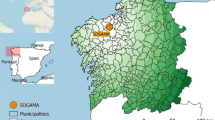Abstract
Biowaste or the organic fraction of domestic waste, for instance kitchen, fruit and garden waste, is collected selectively in several European communities. The complementary fraction is called the dry or non recyclable fraction. A Dutch study reported that 92% of the participants that have a weekly collection service of both fractions (biowaste and non recyclable fraction) and 80% of the participants in the alternating collection program (one week biowaste and the next week non recyclable fraction) are pleased with separate collection of biowaste. Dominating problems that arise in case of alternating collection are a repulsive odor and an infestation with flies and maggots. By expanding the definition of biowaste to include non recyclable or soiled paper like dirty newspapers, table napkins and paper handkerchiefs, most of these problems can be overcome without changing the way compostable waste is collected and processed. The expanded definition of biowaste was used in this paper. Over a 12 month period a quality survey of the collected biowaste was conducted by the composting facility Intercompost, Hoeselt, Belgium. A special aspect was the fact that in one participating community baby diapers were included in the soiled paper fraction; this is called “biowaste+”. The biowaste+ had a 10% non recyclable paper fraction opposed to only 1–2% of non recyclable paper present in the conventional biowaste. Baby diapers were a rather notable part (more than 80%) of this non recyclable paper fraction of biowaste+ and as a consequence might contribute to a large extent to improve the collection and treatment of biowaste. It was demonstrated that rural districts yielded about 35% more biowaste than more urban districts; resp. ± 122 kg biowaste/capita.year versus ±90 kg biowaste/capita.year. In Hoeselt the biowaste+ yield was about 130 kg/capita.year. Biowaste+ is also separately collected in another Belgium community, namely Brecht. The purity level of the biowaste+ and the amount of non recyclable paper (including diapers) were comparable with the results of Hoeselt. In Hoeselt the biowaste+ fraction is composted aerobically. In Brecht on the other hand, the biowaste+ is processed using the Dry Anaerobic Composting process (DRANCO). The latter process is discussed in more detail. The biological start-up of the dry anaerobic composting installation at Brecht, Belgium, is reported. The reactor has a total volume of 808 m3 and a design capacity of 730 m3. After 2 months of start up, the fermentor was at full loading rate, i.e. 8 kg bVS/m3 reactor .day and the installation was working at full capacity, i.e. 40 ton/day. After 1 year of full-scale operation, the installation can handle peak loads of 60 ton/day. The average biogas production is 107 m3/ton with an average methane content of 55%. This corresponds to an annual gross energy production of approximately 600 toe (ton oil equivalent). The average biogas production rate is 4.0 m3/m3 reactor .day. The end product of the aerobic process in Hoeselt and the end product in Brecht, the Humotex, are of similar composition. Both are of high quality and are sold as a soil conditioner or as a potting substrate. However, the double processed compost has a garanteed hygienic quality which makes it a product suitable for export.
Similar content being viewed by others
References
Artois J (1991) Sensibilisering. In: OVAM, Direktie preventie en rekuperatie. Masterplan GFT- en groenafval. Mechelen, Belgium
De Baere L, Six W, Tillinger R & Verstraete W (1992) Waste paper improves biowaste composting. BioCycle, September: 70–71
De Rijcke A (1992) Eindrapport proefprojekt; Selektieve huisvuil-inzameling te Hoeselt; periode juni 1991-mei 1992. University Gent, Laboratory Microbial Ecology, Gent, Belgium
De Wilde B, Six W & De Baere L (1989) Verwerking van organisch afval door droge anaerobe konversie-Voordelen van gescheiden GFTP-inzameling. Studiedag Gescheiden inzameling en herverwerkingsmogelijkheden van huisvuil in Vlaanderen (pp 1–9). Gent, IFEST-beurs, Antwerpen, Belgium
Francke M (1990) Approach of a multinational company to assist management of solid waste — a research program for baby diapers. Proceedings Resource recovery from waste. Ecosette, Imola, Italy: B1–B13
Gellens V (1994) Eindrapport proefprojekt selektieve huisvuilinzameling GFT- versus GFTP-inzameling, -kompostering en kompostkwaliteit; periode mei 1992-april 1993. University Gent, Laboratory Microbial Ecology, Gent, Belgium (in press)
GFT Infopunt (1992) Wekelijks versus alternerend ophalen. Den Haag, The Netherlands
Lemmes B (1993) Composting, anaerobic digestion and cold pretreatment. ORCA, The orcazette, Brussels, Belgium. June: 4–5
Obermeier T, Jager J, Francke M, Jager E & Rüden H (1991) Cocomposting of diapers and biowaste using the box-composting and rotating drum process. In: 2ndKasseler Abfallforum. Conference on biowaste composting (pp 1–37) University Kassel
OVAM (1991) Masterplan GFT- en groenafval. Oirektie preventie en rekuperatie, Mechelen, Belgium
Struve K (1991) Packaging is targeted for waste reduction. BioCycle, March: 45
Umweltbundesamt (1987) Daten zur umwelt 1987/88. Umweltbundesamt Berlin, E. Schmidt Verlag
Van Belle W (1992) Biowaste definition. KVIV-studiedag Verwerkingsmogelijkheden en scheidingsregels van groente-, fruit- en tuinafval. Gent, Belgium. 7 March, 2018 Antwerpen, Belgium
Vande Woestyne M, Gellens V, Anas I & Verstraete W (1994) Anaerobic digestion and inter-region recycling of organic soil supplements. FAO Symposium, Israel, 9 June. In press.
Vogtmann H & Fricke K (1992) Source separation of biogenic waste. BioCycle, June: 30–33
Author information
Authors and Affiliations
Rights and permissions
About this article
Cite this article
Gellens, V., Boelens, J. & Verstraete, W. Source separation, selective collection and in reactor digestion of biowaste. Antonie van Leeuwenhoek 67, 79–89 (1995). https://doi.org/10.1007/BF00872196
Accepted:
Issue Date:
DOI: https://doi.org/10.1007/BF00872196




